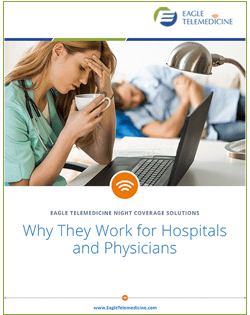Can telemedicine coverage help your staff improve care? Nurse practitioners and physician assistants are the backbone of hospital care, providing very necessary hospital night coverage when a physician isn’t on-site. However, when there’s a question about a patient’s care, they are often hesitant to wake the on-call physician – respecting the doctor’s need for a good night’s sleep. When the patient must be seen, the on-call doctor will arrive as quickly as possible – but a delay is simply unavoidable.
Telemedicine can be a lifeline in these situations, supporting nurse practitioners and physician assistants by providing access to virtual physicians 24/7. These highly experienced physicians are available to “beam in” at a moment’s notice to guide and advise your staff in providing comprehensive care. TeleHospitalists and TeleNocturnists lead daily patient rounds via live video conferencing, and function as a member of your hospital’s clinical team.
These remote providers are on-call to answer questions and consult directly with patients whenever necessary. There’s no need for nurses and advanced practitioners to worry about waking up the dayshift provider who is also on-call at night – Eagle’s TeleHospitalists are prepared, awake and ready for the call.

Nurse Practitioner Praises Eagle’s Telemedicine Coverage
Patterson Health Center rural Kansas is a perfect case study that demonstrates how TeleHospitalist programs support NPs and PAs in rural areas. At Patterson, Eagle’s remote providers served as backup for the inpatient facility, Emergency Department and the rural health clinic, providing support for two NPs and three PAs who work night shift at the 25-bed hospital.
The on-site providers came to view telemedicine as an essential component of the hospital’s care team. In fact, the on-site team believes the TeleHospitalists have not only helped the patients, but also given the on-site staff more confidence.
Many NPs graduate with certification to work in family-practice clinics, but may not have training in the acute care setting of a hospital. They often gain inpatient care experience via hospital Emergency work, which leads to patient care on the nursing floors. They continue to learn from day shift nurses and physicians in the hospital, and check with on-call physicians at night when they have questions – or want to confirm their next steps.
Eagle’s TeleHospitalists have given this backup process a more consistent structure and a more comprehensive, effective approach. NPs and PAs have found they can discuss each patient with their TeleHospitalist any time of day, giving them a broader perspective on patient care.
The result: fewer patients had to transfer to a distant tertiary hospital because advanced practitioners can make more confident decisions during the hospital night shift. The hospital can keep patients onsite knowing the level of care needed is available locally.






